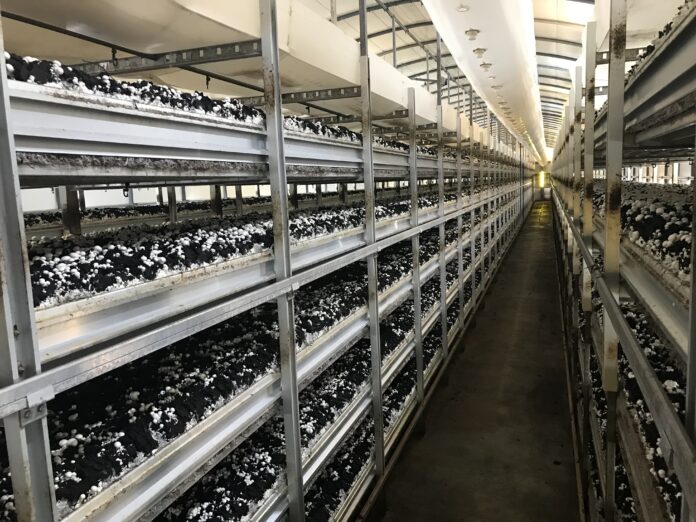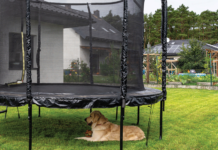Donal Gernon, specialist mushroom adviser with Teagasc, explores the advances currently being made in the field of mushroom production automation
Like other horticultural enterprises, commercial mushroom production is highly labour intensive. Labour accounts for one-third of a mushroom growers overall cost of production. Mushroom growers face the constant challenge of recruiting and retaining staff to harvest their crops.
The current method of harvesting mushrooms consists of one-handed picking, manually cutting the mushroom stalk, placing the mushroom into the punnet, weighing the punnet to ensure it reaches the correct weight specification, labelling the punnet, and placing the punnet into the crate. This has been the standard process since mushroom production began. However, as the availability of skilled labour evaporates, the industry must look at streamlining the process to maximise harvesting efficiency.
On the current conventional mushroom farm, the average pick rate is between 25-30 Kilograms of mushrooms per hour. This pick rate is achieved by adopting basic harvesting principles such as graze picking and separation. Pick rate can vary from farm to farm depending on size specification per product and product mix.
Over the past two decades, many growers have been forced to close their mushroom enterprise due to difficulties found in recruiting and retaining staff to harvest their crops. Unfortunately, unless mushroom harvesting automation is developed and adopted, this trend is set to continue. Due to the sensitivity of the mushroom, designing a robot to aid in harvesting is a very difficult task. The emphasis from mushroom engineering companies currently focuses on designing semi-automated systems that will increase harvester productivity by introducing two-handed picking.
Various concepts have been designed and implemented with positive results on farms all over the world. Some of these designs can be implemented into the existing mushroom tunnel structures and some technologies require investment in new buildings and infrastructure.
TILTING SHELVES
The tilting shelf system is a method whereby a standard shelf is divided into two sections that tilt towards the harvester at a 45-degree angle. This makes it much easier for the harvester to see the current crop and to harvest the correct mushroom. The tilting shelf eliminates the strain of reaching across the mushroom bed to harvest mushrooms which in turn speeds up the picking process. The shelves are only tilted during harvesting and they return to the horizontal position once picking has ceased. A mushroom conveyor runs alongside the shelves, the harvester places the mushroom into designated slots and the conveyor transports these mushrooms out into the central corridor, where the mushrooms are placed in punnets.
DRAWER SYSTEM
The drawer system is a system whereby a farm is designed so that crops are winched from one growing room to another during the harvest period. A picking station is located in the central corridor and the crop is pulled to the harvester. This is in comparison to the conventional picking system where harvesters move through the crop within the tunnel. The crop can be pulled across from one growing room to another several times a day to allow the harvester to easily graze pick and thus maximise mushroom size and yield. The two big advantages to this system are that the harvester only needs to focus on one area and it is visually much easier to identify and pick the correct mushroom as there is no crop directly above the shelf.
SINGLE LAYER
The single-layer system involves crops being grown in specific growing rooms up until mushrooms are ready to be harvested. They are then winched into the harvesting room. In the growing room, the crops are stacked on traditional Dutch shelving. In the harvesting room, the crop is brought down to a single layer which makes it easier for harvesters to pick compared to picking on a high-level picking trolley. Pick rates are much higher on this system. However, this could not be implemented on an existing conventional farm. A major challenge for the single-layer system is managing the growing environment. Airflow can be difficult to perfect which can result in quality issues. Another factor that needs to be considered is that a grower would need to acquire a larger site to construct this system.
MUSHROOM PROCESSING UNIT AND CONVEYOR
This system involves a conveyor, installed alongside the existing Dutch shelving, that transports mushrooms to the end of the shelf where the mushroom processing unit (MPU) is placed. This machine collects the mushrooms off the harvesting line, where the stalks are cut at the desired optimum length and placed into the correct punnet based on the mushroom size that the operator sets when commencing production. The processing machine is transferable between harvesting lines and tunnels so the farm would only need to invest as many of these machines as the number of tunnels harvesting at any given time. The conveyor would need to be installed in each stack of shelves in each tunnel. This system can be integrated into the existing Dutch shelving system and the existing picking trolleys can also be utilised.
RESULTS
These harvesting systems all have one thing in common: they will allow harvesters to pick mushrooms with both hands and eliminate tasks such as cutting the stalk, grading the mushrooms, and weighing the punnets. Other secondary tasks like emptying the stalk bucket, preparing harvesting equipment, and obtaining packaging will also be eliminated. All of these systems are designed with one aim in mind – to increase harvesting pick rates which would allow a farm to reduce the harvesting workforce. These systems achieve this target with average pick rates of 55-80kg/hour, a significant increase, and fewer harvesters are required to pick the same amount of growing area which is a huge benefit.
Average yields increase with the implementation of automated systems as they allow for easier graze picking and for mushroom sizes to be maximised. Also, consistent stalk lengths are optimised with the introduction of automated stalk cutters. The average yield increase is estimated to range from 3-10%.
CHALLENGES
Significant capital investment is required for growers to invest in any of these automated systems. Although these systems have been installed in farms in Europe and Canada, there is no guarantee that they will be a success on Irish and UK farms that harvest a higher percentage of baby buttons and small closed cup mushrooms. Many of these systems are unable to accommodate flat mushrooms, which need to be placed in punnets upside down. These small factors have a major influence on productivity and the rate of return on investment. Some automated systems cannot be integrated into existing units, meaning a new farm would need to be constructed, which is an enormous investment.
Quality and presentation are also important factors to be considered when investing in automated technology. Some of these systems allow for double handling as mushrooms are picked off the crop, placed on the conveyor, and then picked off the conveyor again to be placed in the punnet. This results in mushrooms being bruised and marked. Mushrooms placed in punnets by robots are sometimes not presented as attractively as a harvester might. Robots placing mushrooms into punnets are not able to grade poor quality mushrooms and these mushrooms may end up in high-grade products. This could lead to customer rejections.
CONCLUSION
The rate of investment in automated technologies is accelerating due to the shrinking labour market. To allow growers to invest in such technologies, access to grant aid is essential. Trialling a system on a small scale is recommended to assess the functionality and performance. The introduction of mushroom robotic harvesting in the future must also be taken into account before making a substantial investment. Many companies are actively working to develop a robot that will harvest mushrooms, but not all semi-automated systems are designed with robotic harvesting in mind. ✽

Donal Gernon is a Specialist Mushroom Advisor with Teagasc. Donal provides technical assistance to all mushroom growers in Ireland and keeps growers updated on new mushroom picking technologies. |







